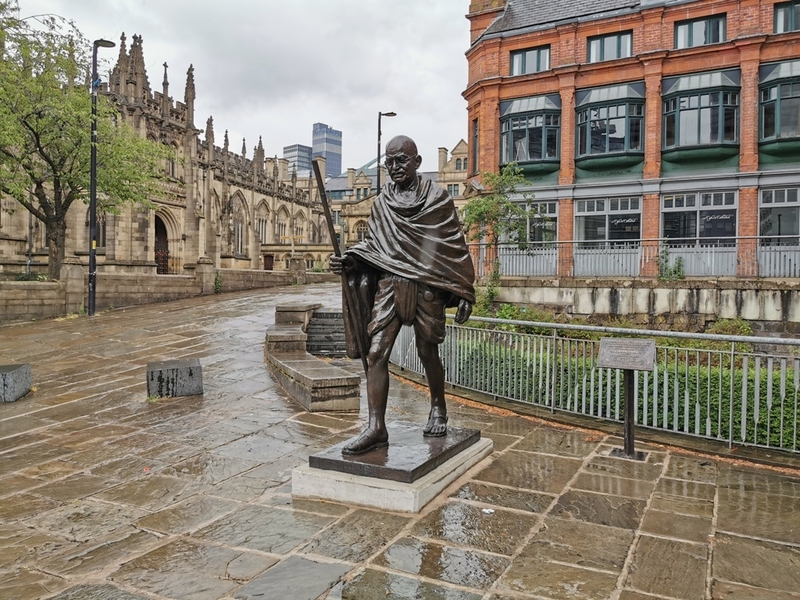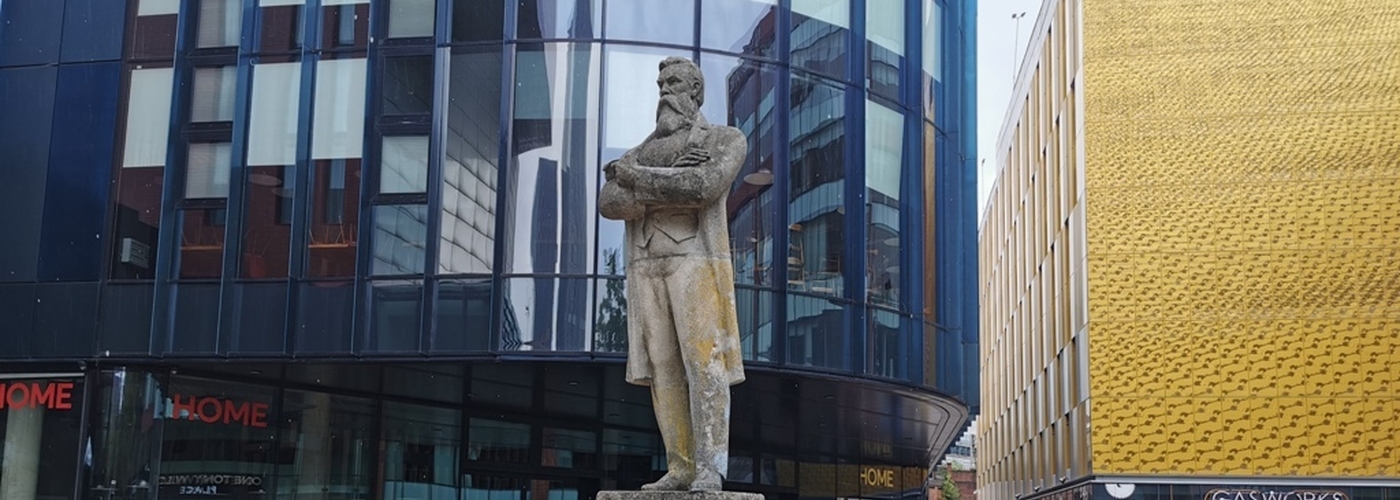Jonathan Schofield suggests a solution to the statue issue
Three Manchester statues have attracted protests at their erection. The first two may be unexpected.
In 2017 Phil Collins, the Berlin-based Oldham artist, as part of a Manchester International Festival project, recovered a statue of Friedrich Engels from a farmyard in Ukraine. It was in two halves. Like Humpty Dumpty, Freddie was put back together again. He now stands outside HOME arts centre in Tony Wilson Place. He looks surprised to be back. He lived here for 22 years between 1842 and 1869 during which he co-authored The Communist Manifesto.
We already have a statue that has been pulled down
The Ukrainian community in Manchester were surprised he was back too, and outraged. Forget about the sins of the father discussed in the previous two articles about statues (here and here), they were after the sins of the theorists. Engels and Karl Marx, with their advocacy of communism, are held directly responsible for the Soviet Union. And thus the absolute monster that was Stalin. On the Ukrainian Church in Cheetham Hill there is a memorial to the Great Famine. This was Stalin’s man-made human cull in the Ukraine, the Holodomor, which, during botched forced collectivisation, killed a minimum of 3.5 million. It was cruel, brutal oppression.
The irony of the call to drop Robert Peel is that we already have a statue that has been pulled down. When Ukraine gained independence in 1991, statues of Marx and Engels were daubed in the national colours of yellow and blue and smashed. The Manchester statue still bears the yellow and blue paint it was covered with before it was dragged down and split in two.
Of course Engels (or Marx) no way imagined the brutal Soviet Union would be seen as his and Marx’s legacy - as the Francis Wheen quote in the first article of this series underlines. You might as well blame Jesus, Mohammed and Buddha for the cruelty and slavery and violence done in their name.
Engels would have been appalled by Stalin. Yet Engels is one of the two most potent symbols of both pure Marxism and the debased reality of regimes which have declared themselves Marxist. This symbolism mattered to many in the Ukrainian community. Remember this statue had been dragged down in its country of origin and reassembled here. As stated previously I am writing a book about Engels & Marx in Manchester and I personally see no purpose in this statue, not least because it was a piece of mass-produced propaganda tat by a paranoid Soviet Union.
Then there is Mahatma Gandhi’s even more recent statue outside Manchester Cathedral. Gandhi surely can’t attract protests can he? Through persuasion, persistence and modesty this gentle man ripped the jewel in the crown of Empire, India, from the British grasp. I too, proud of my historical knowledge, blithely accepted the idea of the compassionate campaigner until I learnt another truth from his earlier years.
So when his statue was erected outside Manchester Cathedral last year I was surprised that some people were disgusted.
As a young barrister in South Africa, Gandhi was not so virtuous as his reputation suggests. He thought the black African population was inferior to Indians and the white community. When he asked for greater rights for the Indians he explicitly stated that those rights should not be extended to black Africans - or Kiffirs, he wrote adopting the vile and insulting word. Apologists for the young Gandhi say he was a nipper, operating within a British colonial system. In other words the Empire was to blame. Not that he was a hot-headed youth at a particular time and place.
In the Guardian in 2019, Meena Dhanda from the University of Wolverhampton said it wasn't a surprise that 'the more people have begun reading Gandhi rather than merely idolising him, the more they are finding out about his racism. As scholars have shown, he was terrified of intermixing, he upheld caste rules that restricted marriage outside one’s caste. He stereotyped people; for instance he wrote ‘Mussalman as a rule is a bully and a Hindu a coward’ and ‘Kaffirs are as a rule uncivilised.’ Despite his political actions harnessing the force of ‘non-violence,’ his underlying metaphysical views were deeply at odds with modern sensibilities.'

The third existing statue to attract protest, although it was largely in the form of letters way back upon its erection in 1875, was that of Oliver Cromwell. The self-proclaimed Lord Protector of the country after the execution of Charles 1 during the English Civil Wars now stands in Wythenshawe Park. In a middle-class, often non-conformist city in the nineteenth century, Cromwell was seen as the great defender of freedom in faith and conscience (as long as you weren’t Roman Catholic.) He was the man who had dramatically demonstrated how Britain would not tolerate an absolute monarch.
The problem was that as soon as he was in control he became a tyrant himself. The fact Cromwell was quite capable of dismissing Parliament as much as the late king was ignored. In reality Cromwell, a Puritan, was a religious fanatic, who thought he received direct instruction from God. As one Manchester Guardian writer put it in the nineteenth century: ‘His contemporaries did not dispute that he wrestled with the Lord. They took it rather hard that he thought he’d won.’
There were many in Manchester who thought the Cromwell statue, which was originally outside Manchester Cathedral, was a disaster. They pointed out that given the utter savagery of Cromwell’s campaigns in Ireland and his brutality in Scotland this monument would undermine the union of the Kingdom. The mood was caught by one Mr Hayden who said: ‘It is quite possible that many Englishmen may favour the erection of a (Cromwell) statue, but Irishmen look upon the name of Oliver Cromwell with a horror and hatred and bitterness which can scarcely be excelled.’
The statue was moved to Wythenshawe Park in 1968 to ‘make way for a one-way road system.’ Almost immediately on arrival in the park the statue was defaced.
By the way, just to prove how awkward history can be, Cromwell was the man who invited the Jewish community back into Britain after they had bloodily been expelled more than three centuries earlier in 1290.
From Peel to Gandhi it's clear that people cherry-pick the bits of history they want and don't want.
In other words, nobody wants to hear the full story of their heroes as it is impossible for them to bear up to scrutiny - especially in an age which seems to demand a sort of perfection of behaviour from even the dead.
The Manchester statues show there will be times when they or their ancestors failed to live up to our standards at one point or another but they also show that frequently people could turn their back on earlier opinions and reform - William Gladstone for example.
The mirror to that, of course, is that nobody wants the full details of their villains either. They want them to be consistently beastly, which is as unlikely as heroes being permanently virtuous.

I think there is a solution and I think we sort of had it in our 2013 article here, albeit written in different times.
In that article artist Liam Curtin proposed that people populating the plinths should be painted as lifelike as possible so instead of walking past, head down, we might notice them. And as we stated in the first article, each would have biographical plaques and links to websites with competing opinions. The text should be matter of fact. Emotion-free. Objective. No opinion offered.
In this way we let people judge the personalities on the statues by whatever 2020 standards they choose while also learning something about history. The city will be better explained. And brighter. It would be a first in any city - and Manchester likes to claim pioneering episodes. At the same time the continuity and complexity of Manchester life through the ages would be revealed, showing how everything is linked. So keep the statues on the street, bring the history class out of the classroom and into the open.
Put the stories in people's faces.
















